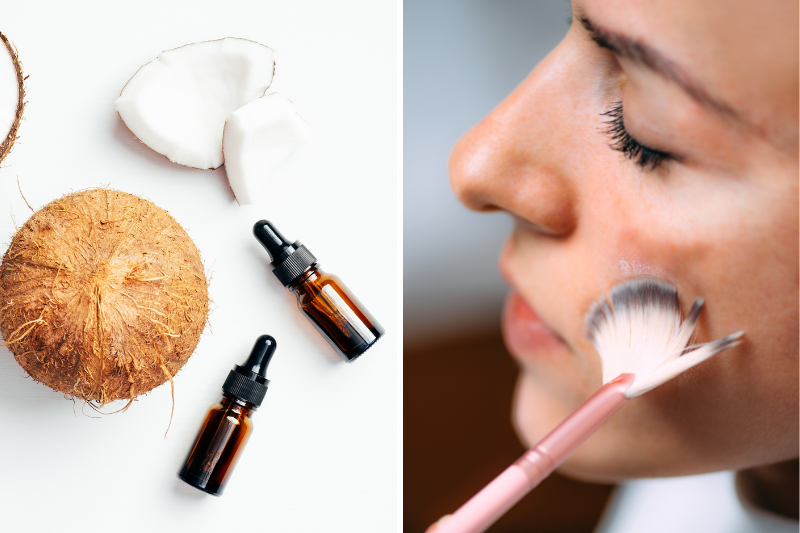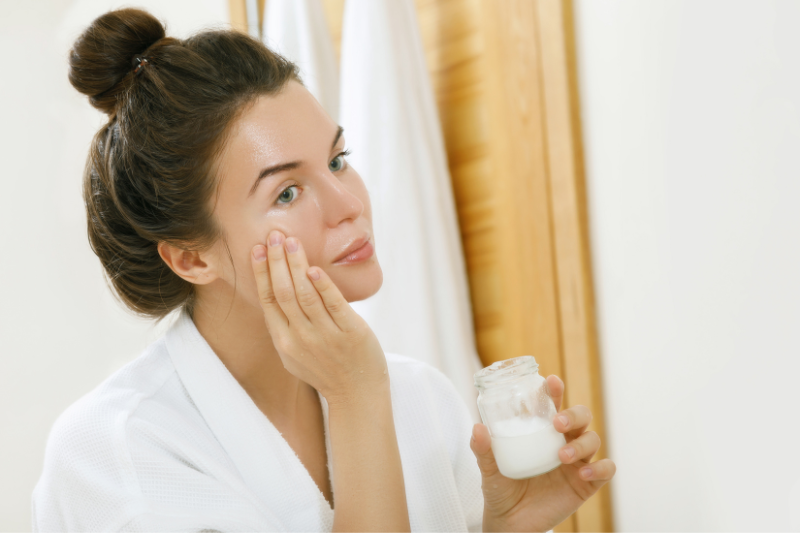Have you ever thought about using coconut oil for pigmentation? Hyperpigmentation can happen for many reasons, and they’re all frustrating. You may notice hyperpigmentation with sun damage, scarring, or aging skin.
Hyperpigmentation is not usually dangerous, but it can be embarrassing.
Coconut oil is quite effective at reducing the appearance of hyperpigmentation. With regular use, you should begin to notice your skin tone even out. At the very least, you’ll notice that your skin is becoming happier and healthier.
Keep reading to find out how as below I cover everything coconut oil and hyperpigmentation including what they both area, how coconut oil works on skin discoloration and exactly how to use coconut oil on hyperpigmentation for the best results.

What Is Coconut Oil?

Coconut oil is an oil that comes from the fruit of the coconut palm, Cocos nucifera.
Coconut Oil For Cooking
Many people use coconut oil in cooking. Many people believe it is a healthy oil to cook with. Yet, most nutritionists disagree. Coconut oil consists of over 80% saturated fat.
When it comes to cooking with and eating fats, you should try to stick with unsaturated fats. You should keep saturated fats to a minimum. You should avoid trans fats at all costs. So, an oil consisting of over 80% saturated fat isn’t going to be very good for your health.
Coconut Oil For Skin
Instead, you should consider using coconut oil for your skin. You’ll receive many more health benefits this way. Coconut oil moisturizes the skin, heals wounds, and yes — reduces hyperpigmentation.
The same saturated fats that are bad for you to ingest will help your skin become more moisturized.
There are two different kinds of coconut oil that you can choose: copra oil and virgin coconut oil. I recommend going with virgin coconut oil.
Virgin coconut oil is better because it contains more nutrients. Nutrients like vitamin E and polyphenols are going to keep your skin healthy. Both of these nutrients work as antioxidants. They fight free radicals which cause the signs of aging.
What Is Hyperpigmentation?

Hyperpigmentation refers to the abnormal darkening of the skin. This will most often appear in the form of spots that are darker than the rest of your skin. These spots can show up in small patches, or they can cover large areas of the body. Some people will even experience hyperpigmentation over their entire body.
This condition is not usually harmful. Still, many people feel self-conscious about the uneven tone of their skin.
There are many reasons why you may experience hyperpigmentation. Most of these reasons aren’t cause for concern.
The most common forms of “normal” hyperpigmentation include melasma, sunspots, and post-inflammatory hyperpigmentation.
Melasma Hyperpigmentation
Melasma appears because of hormonal changes, so it’s most common during pregnancy. These spots may appear anywhere on the body, but they are most common on the stomach and face.
Sunspot Hyperpigmentation
Sunspots are also very common because of overexposure to the sun. Many people don’t take the proper precautions when venturing outside. This can lead to spots of hyperpigmentation across your body.
The spots will usually occur where your body is most often exposed to sunlight, such as the face and hands.
Post-Inflammatory Hyperpigmentation
Post-inflammatory hyperpigmentation appears after an injury. It often shows up in the form of a scar. These spots are common on the face as they are often a result of acne scarring.
Now you know what coconut oil is, and you know what hyperpigmentation is. But, how do coconut oil and hyperpigmentation work together?
Does It Work To Use Coconut Oil For Skin Discoloration?

Yes, skin discoloration is frustrating, and coconut oil is great for the skin. Still, this doesn’t mean there is a correlation between the two.
Yet, in this case, they do have a connection!
Coconut oil works great for hyperpigmentation, and there are several reasons for this.
Coconut Oil Acts As A Tyrosinase Inhibitor
Skin darkening occurs because of excess production of melanin. Your body’s levels of melanin determine the tone of your skin, but it can also cause your skin to darken. When you get a tan, it’s because of the increased production of melanin.
Tyrosinase is an enzyme that controls the production of melanin in your body. Tyrosinase is normal. But, it can get out of control, producing issues like hyperpigmentation.
Many plants — like coconuts — contain tyrosinase inhibitors. These inhibitors prevent the overproduction of melanin. One such tyrosinase inhibitor is phenolic acid — which resides in coconut oil.
Coconut Oil Contains Lauric Acid
Coconut oil is good for reducing hyperpigmentation because it contains Lauric Acid.
Lauric acid is capable of fading dark spots, including freckles and scars.
Coconut Oil Is Moisturizing
Coconut oil is an emollient that draws moisture deep within the skin. The high levels of saturated fat in coconut oil hydrate the skin and keeps it silky smooth.
It prevents your skin from losing moisture, and it leaves your skin looking fresh and glowing.
Coconut Oil Heals Skin Cells
The main benefit of coconut oil is that it’s moisturizing. It contains nutrients like vitamins E and K, calcium, zinc, iron, and amino acids.
All these nutrients heal damaged skin cells and promote the creation of new skin cells.
Coconut Oil Fights The Signs Of Aging
Hyperpigmentation is a common symptom of aging. Coconut oil is chock-full of antioxidants and fatty acids which increase collagen production.
Collagen is the main protein found in the skin and is what keeps the skin healthy and stretchy. By promoting collagen production, coconut oil increases skin elasticity, reducing skin damage.
Coconut Oil For Hyperpigmentation On Face
Did you know that you can use coconut oil for face pigmentation?
Yes, coconut oil is a gentle carrier oil, so it is safe to use on some skin types. With that said, not everyone should use coconut oil on their face.
Coconut oil will be best for people with dry or normal skin. I don’t recommend using coconut oil on your face if you have oily or acne-prone skin. This is because coconut oil may clog the pores and cause acne.
Coconut Oil For Acne Hyperpigmentation
Coconut oil is useful for reducing the appearance of hyperpigmentation. So, it may tempt you to use it for your acne scars.
Coconut oil can reduce the signs of acne scars. Yet, coconut oil is very comedogenic, so it’s not generally a good idea to use it on your face.
Comedogenic means that a product or ingredient will clog your pores. Clogged pores increase the production of oil and may result in infection. You probably know where this is going. Comedogenic ingredients are more likely to cause acne.
We rate ingredients on a comedogenic scale of 0-5. “5” is highly comedogenic. Coconut oil has a comedogenic rating of “4”, so it is not suitable for acne-prone skin.
Dealing with hyperpigmentation that is a result of acne scarring? Chances are that your skin is acne-prone. You won’t want to use a product on your skin that is likely to cause an acne flare-up and make your situation worse.
Sure, coconut oil will take care of your acne scars, but it will produce more acne to take its place.
Instead, consider similar products that won’t cause an acne break-out. Jojoba oil helps with hyperpigmentation but is non-comedogenic.
Can You Use Coconut Oil For Skin Whitening?
This depends on how much you’re wishing to lighten your skin. You can use coconut oil for hyperpigmentation — aka “abnormal” skin discoloration.
Yet, coconut oil isn’t going to “whiten” your skin, so you can’t use it to lighten your natural skin tone.
How To Use Coconut Oil For Hyperpigmentation

Coconut oil. Hyperpigmentation. Coconut oil works great for hyperpigmentation, but you need to know how to use it.
Use Coconut Oil As-Is
The easiest way to use coconut oil is to use it on its own. Before applying the coconut oil, be sure to wash your skin. This will clear out any oil and dirt from your skin.
Then, massage the oil into the area of your skin where you’re experiencing discoloration. For best results, leave the oil on overnight and rinse it off in the morning.
Buy A Pre-Made Product
If you want, you can buy a product that already contains coconut oil. Many moisturizers and cleansers contain coconut oil as an ingredient.
Another option is to create your own coconut oil recipe. This is a great option because you know exactly what is going into your concoction. You can combine coconut oil with other ingredients that have good benefits for your skin.
You can then apply the mixture to the darkened areas of your skin and let it soak for about 15 minutes. Then, you can wash away the mixture with warm water.
Note that you shouldn’t use this recipe more than once or twice a week.
Below is another simple recipe to rid your skin of unwanted dark spots:
To use, massage the paste into your skin where you’re experiencing the hyperpigmentation and allow the mixture to soak into your skin for about 15 minutes before you rinse with warm water.
You may apply this recipe two or three times a week.
Conclusion
Do you deal with hyperpigmentation? Coconut oil can be effective in reducing the appearance of hyperpigmentation.
Coconut oil is a great moisturizer. It fights the signs of aging, and it works to repair damaged skin.
If you have oily or acne-prone skin, I don’t recommend using coconut oil on your face. Still, you can probably use it on the rest of your body without a problem. Those with normal or dry skin aren’t likely to have a problem using coconut oil on their face.
You are likely to notice a reduction in hyperpigmentation if you use coconut oil. Even if you don’t, you’ll notice your skin begin to appear healthier and smoother.
Discover more wonderful ways to use coconut oil for lips, skin, diaper rash and leather. Also learn how it is compared to shea butter and almond oil. You can find more coconut products, DIYs and guides here.



Comments are closed.